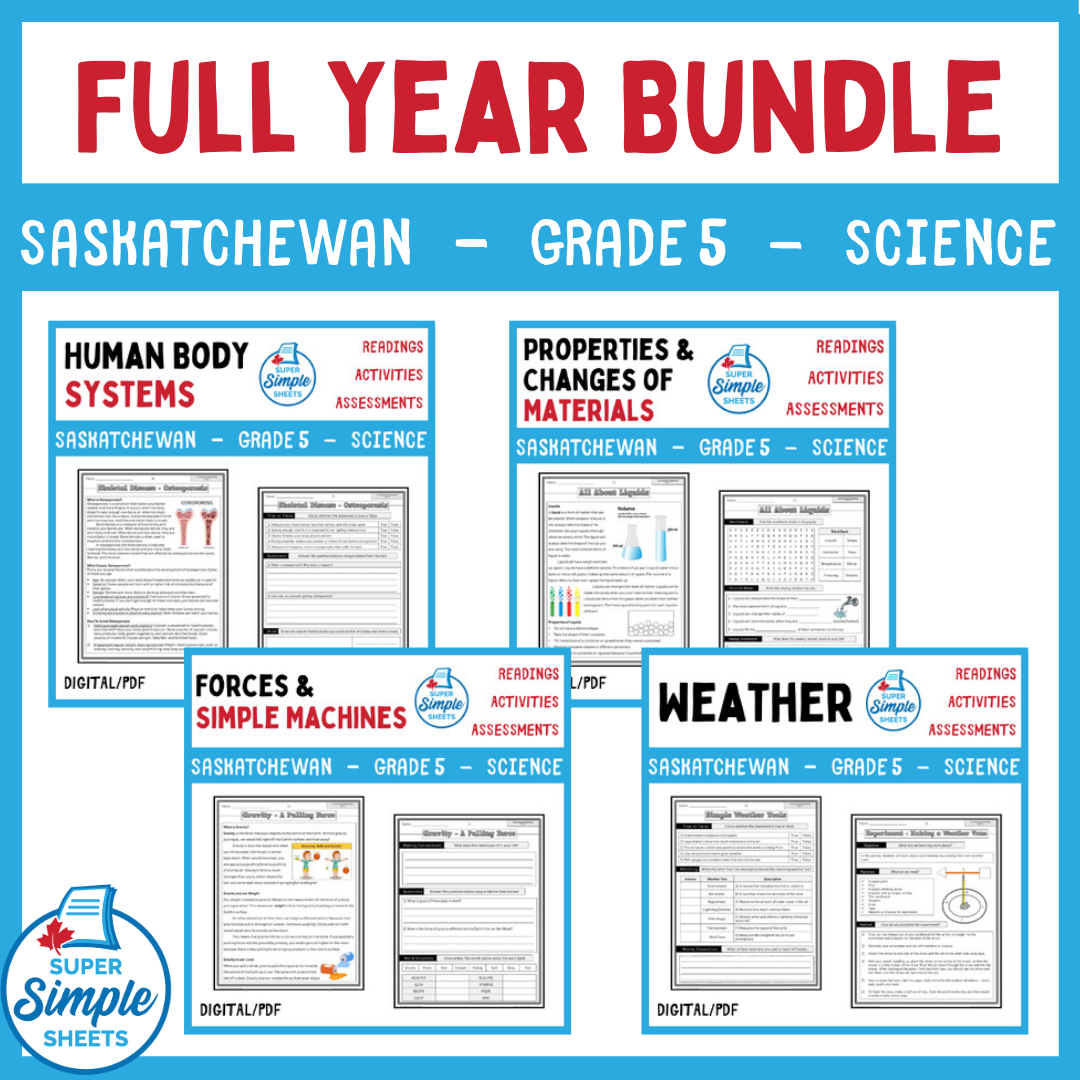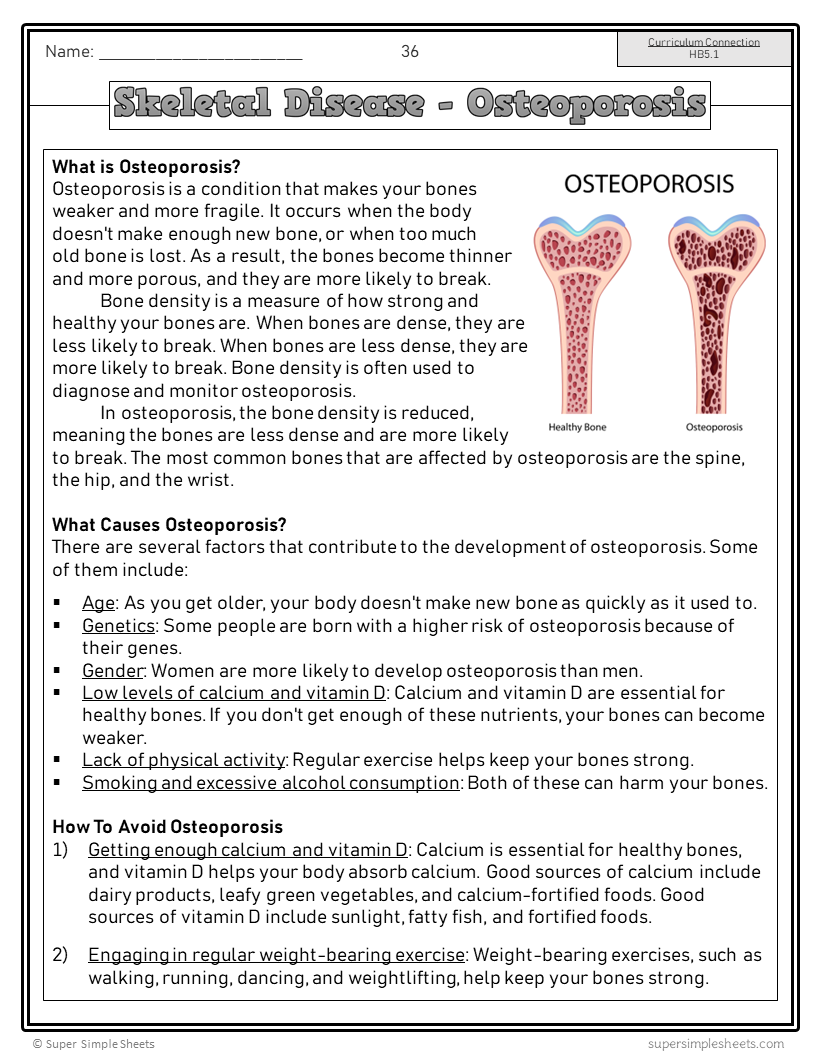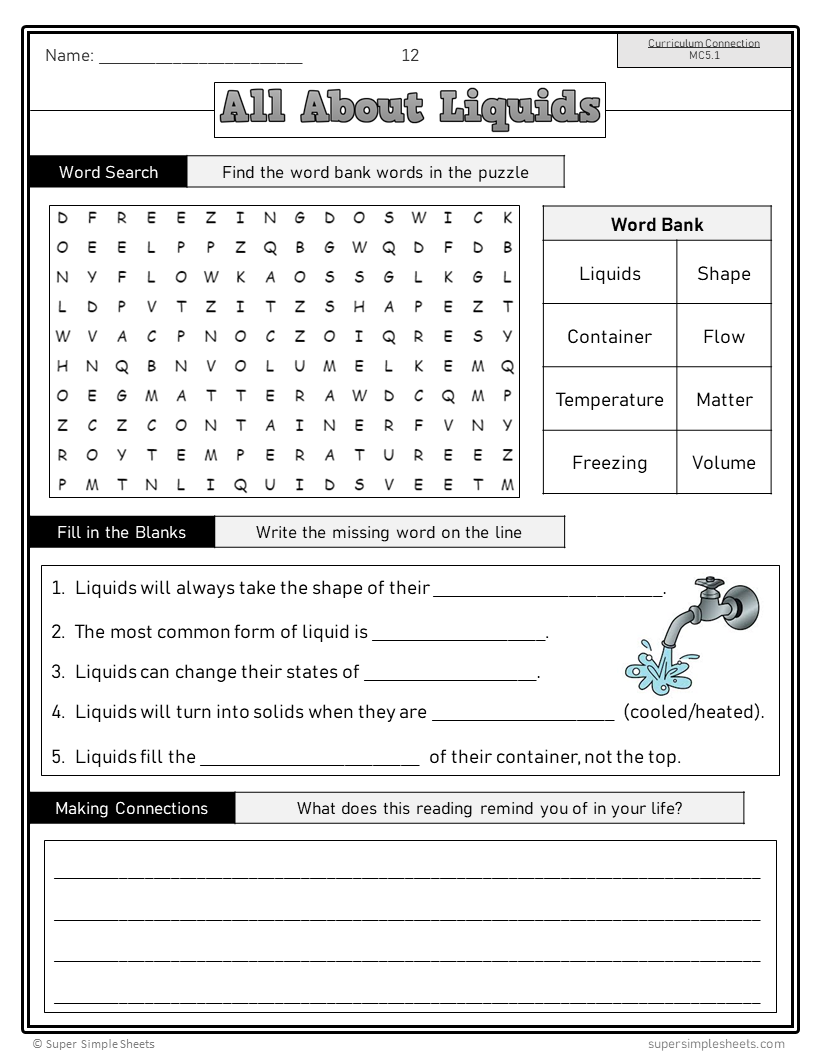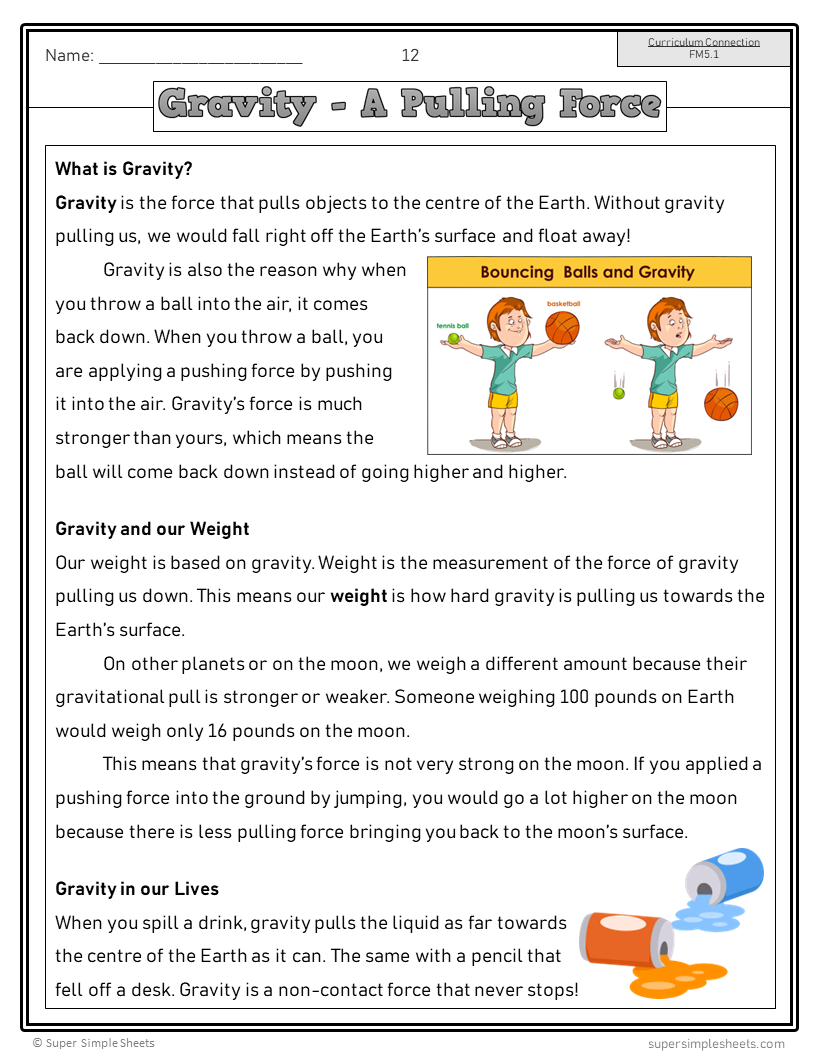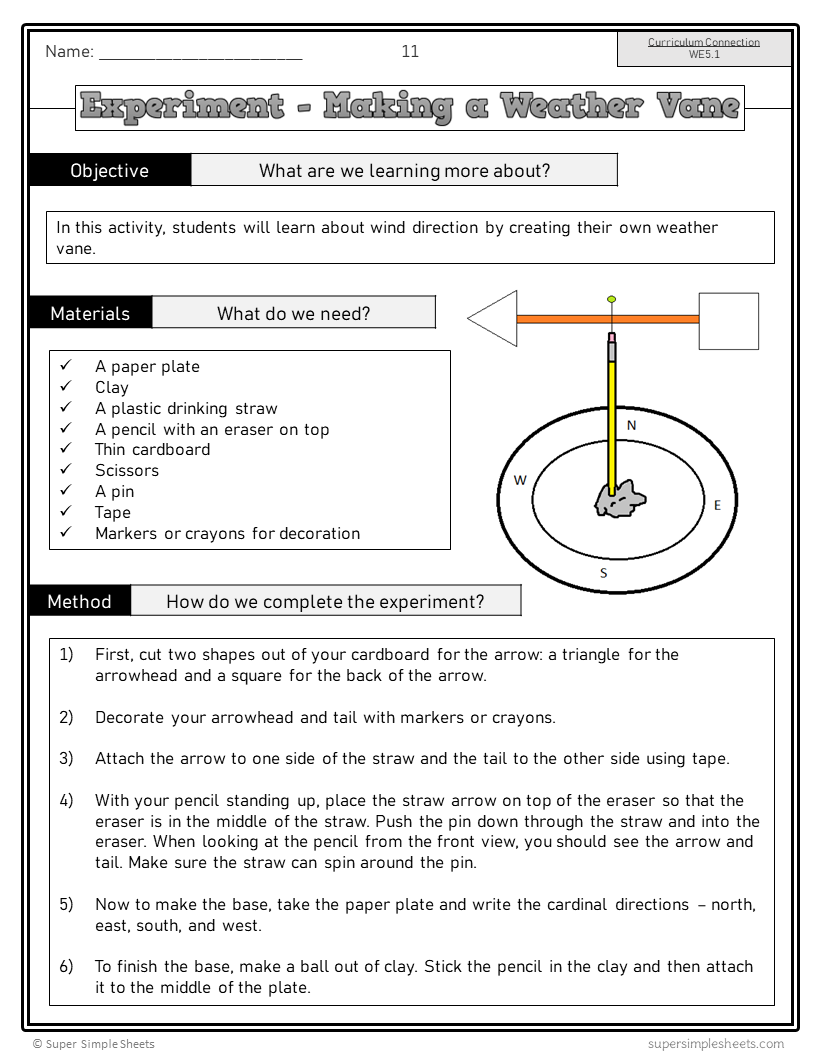Saskatchewan Grade 5 Science - Full Year Bundle - GOOGLE/PDF INCLUDED
Saskatchewan Grade 5 Science - Full Year Bundle - GOOGLE/PDF INCLUDED
Interested in a bundle? Shop below instead!
Couldn't load pickup availability
PRODUCT PREVIEW
Grade 5 – Saskatchewan Science Curriculum – This resource covers all outcomes and indicators in the Grade 5 - Saskatchewan Science Curriculum.
GOOGLE CLASSROOM VERSION - PDF INCLUDED! This gives you the ability to print worksheets as well as distribute a digital copy of the resource to your students on Google Classroom.
Check out each of the strands below to learn more about the resources included in this bundle.
Human Body Systems
Some of the concepts that are covered:
- Introduction to body systems
- Circulatory system – reading and questions
- Heart disease – causes, symptoms and questions
- What is cardiac arrest and CPR?
- Experiment – testing heart rate before and after activity
- STEM assignment – pacemakers
- Coding – writing code for a pacemaker
- Respiratory system – reading and questions
- Respiratory system – activities: matching, diagram, fill in the blanks
- Activity – Paper bag lungs
- Common disease – asthma
- Digestive system – reading and questions
- Experiment – making a model digestive system
- Skeletal system – reading and questions
- Skeletal disease – osteoporosis
- Experiment – demonstrating osteoporosis using vinegar and eggs
- Muscular system – reading and questions
- Nervous system – reading and questions
- Experiment – testing the nervous system with “The Ruler Drop”
- Optical Illusions – Our nervous system tricking us
- Research activity – creating an optical illusion
- Common diseases – stroke and epilepsy
- Nervous system injury – paralysis
- Experiment – Living with paralysis
- Excretory system – reading and questions
- Common disease – urinary tract infection
- Integumentary system – how our skin keeps us healthy
- Immune system – fighting microbes
- Vital signs – body temperature, heart rate, respiration rate, and blood pressure
- Indigenous understanding of body systems
- Interrelations between systems
- Story – Body systems working together: “Jack the Future Olympian”
- Smoking and the Sun – Effects on Health
- Health and Technology – Playing video games
- Robotic surgery – future of healthcare
- STEM Assignment – creating a robot surgeon
- Healthy eating and its impact on our body systems
- Canada’s new food guide – several activities
- Comparing food guides in other countries
- Activities – word search and word scramble
- Unit test
- Answer pages for all activities
Properties and Changes of Materials
Some of the concepts that are covered:
- What is matter?
- All about liquids – physical properties
- Experiment – testing the viscosity of liquids
- Compressing liquids – hydraulic systems
- Characteristics of solids
- Real-world applications of solids
- Experiment – testing the weight of solids versus liquids
- Buoyancy – density of solids
- Experiment – testing the buoyancy of solids and liquids
- Activity – making a floating boat
- Solids that absorb or repel water
- Experiment – materials that absorb or repel
- All about gases
- Experiment – does air have any weight?
- All about air – properties
- Lighter than air flying devices – hot air balloon and airships
- Using gases – pneumatic devices
- Chemical versus physical changes
- Physical changes – cotton materials, cutting materials, freezing/warming materials
- Experiment – whipping cream physical change
- Making dyes from plants – physical change
- Experiment – Indigenous making dyes
- Chemical change – burning, dissolving, making plastic/rubber
- Physical changes – heat and changing states of matter
- Melting point – reading and experiment
- Freezing point – reading and experiment
- Boiling point – reading and questions
- Evaporation – reading and experiment
- Condensation – reading and experiment
- Sublimation and deposition
- Properties of materials
- Choosing the right material
- Assignment – manufacturing a product and choosing the right material
- Types of packaging materials
- Decreasing waste – 3 Rs and beyond the 3 Rs
- Toxic waste
- How long waste takes to decompose
- Handling dangerous chemicals and safety hazard symbols
- Unit test
- Answer pages for all activities
Forces and Simple Machines
Some of the concepts that are covered:
- Non-contact forces – magnetism, electrostatic, and gravity
- Gravity – a pulling force
- Experiment – dropping different shaped objects and objects with different masses
- Experiment – Egg Drop
- Magnetism – using magnetic force to move a car
- Frictional force – static friction, rolling friction, and sliding friction
- Experiment – friction car ramp
- Experiment – frictional force power
- Contact forces – muscular force and spring force
- Balanced and unbalanced forces
- Force diagrams – deciding which direction the object will move
- Calculating the net force acting on an object
- Objects changing direction – sports
- Simple machines – wedge, lever, inclined plane, screw, pulley, and wheel and axle
- Wheel and axle – mechanical advantage
- Experiment – Creating a clothespin car and a balloon car
- Gears – spur gear, idle gear, bevel gear and worm gear
- Bicycles – using gears
- Gear trains and gear ratios – mechanical advantages
- Pulleys – fixed pulley, moveable pulley and complex pulley
- Pulleys - calculating mechanical advantage
- Pulley systems in our everyday lives
- Experiment – creating a pulley system
- Levers – types (class 1, class 2, class 3)
- Experiment – creating a lever system
- Calculating the mechanical advantage of levers
- Inclined planes – mechanical advantage and uses in our lives
- Wedges – everyday uses and diagram
- Screw – everyday uses and diagram
- Complex machines – scissors, wheelbarrow
- Natural versus human-made complex machines
- Muscular-skeletal system – levers in our bodies
- Importance of machines in our lives – backhoe
- Calculating work in Joules – force times distance
- Calculating power in Watts – work divided by time
- Horsepower versus torque in vehicles
- Researching vehicles – horsepower, torque, fuel economy, towing capacity
- Electric vs fuel burning vehicles (machines) – effects on the environment
- Activities – word search and word scramble
- Unit test
- Answer pages for all activities
Weather
Some of the concepts that are covered:
- What is weather?
- Simple weather tools – anemometers, wind vanes, barometers, hygrometers, rain gauges, thermometers
- Experiment – making a weather vane
- Experiment – making an anemometer and graphing the results
- Experiment – making a rain gauge and graphing the results
- Weather forecasting – historical methods (weather lore, observations, and animal behaviour)
- Weather sayings for forecasting weather
- Weather forecasting – current methods
- Weather stations, satellites, and computer models
- RADAR – predicting weather
- RADAR coding activities
- Investigating weather reports – local weather report
- Hourly weather reports
- Activity – making a weather map of Saskatchewan
- Types of clouds
- Properties of air – takes up space, has weight, has pressure, moves (wind)
- Air pressure – wind
- Experiments – power of air pressure and air compression
- Experiment – detecting air pressure and its effects on weather
- Thermal energy – heat transfer from the sun
- Experiment – effects of solar energy on different surfaces and graphing the results
- The Sun’s energy and how it heats Earth’s surfaces (islands, deserts, forests)
- Passive versus active solar heating for homes
- Global water cycle – powered by solar energy
- Experiment – convection heat transfer
- Hot air balloon – how air moves
- Sea versus land breezes
- Microclimates – Victoria, BC
- Experiment – Finding microclimates on your school yard
- Research – extreme weather in Canada (warmest temperature ever, most rainfall ever, etc.)
- Research – extreme weather on Earth (warmest temperature ever, most rainfall ever, etc.)
- Severe weather events – tsunamis, tornados, hurricanes, cyclones
- Structures built to withstand severe weather
- Natural phenomenon – evacuation orders
- Coastal storms- flooding and storm surges
- Climate change – Paris Agreement and monitoring air temperature
- Monitoring glacial melting
- Life without a weather forecast
- Story – Living without a weather forecast
- Assignment – creating an advertisement for a new product that helps survive different weather
- Unit test
- Answer pages for all activities
This is a comprehensive bundle that will save you hours of planning! It has been tested and found effective in helping students achieve the learning outcomes in the science curriculum.
Answer pages for all slides/sheets are included!
Share
